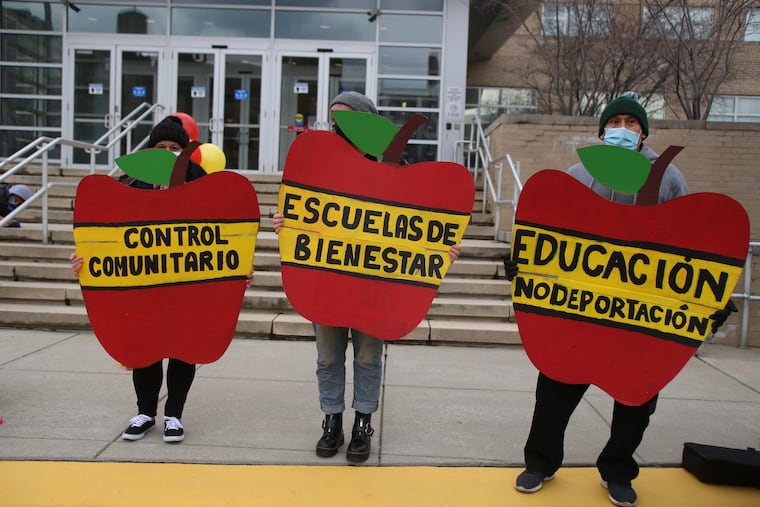Philadelphia needs ‘sanctuary schools,’ immigrant rights group demands
“How is it that parents bringing their children to school have that fear of being picked up by ICE? … We need to say no to ICE," a school counselor told a group outside the district's headquarters.

The Philadelphia School District must commit to “sanctuary schools” where immigrant students and their families feel safe, activists say.
Though the school system has policies in place directing staff not to release any information about students if approached by U.S. Immigration and Customs Enforcement agents, most staffers are unaware of them, the immigrant rights group Juntos said.
This week, the South Philadelphia-based advocate launched a campaign calling for stronger policies and more supports for immigrant students.
“This is a sanctuary city,” Rodrigo Fernandez, a bilingual counselor at Southwark School in South Philadelphia, told about 50 parents, children, activists, and city officials who gathered outside the district’s North Broad Street headquarters Monday. “How is it that parents bringing their children to school have that fear of being picked up by ICE? … We need to say no to ICE. We need to not open the door ever.”
A pregnant mother from Honduras was detained by ICE last year after she dropped off her child at Kirkbride Elementary in South Philadelphia, causing widespread panic among the immigrant community.
» READ MORE: Philly-based group launches $3M initiative to develop Black teachers
Students and parents must know they’re safe from enforcement, and also have strong voices in how schools operate, said Juntos executive director Erika Guadalupe Nunez. The establishment of sanctuary schools, she said, is a call for freedom from criminalization, reinvestment in education, culturally responsive teaching, community control of schools, and schools to be places of healing.
Though the district has a lengthy “toolkit” educating district staff about how best to support immigrant and refugee students, a recent Juntos survey of 350 district administrators and teachers found that 75% of staff said they had received no training regarding ICE and 73% said they did not know who to notify if ICE made inquiries about students.
“For us, that was really concerning,” said Zia Kandler, a Juntos organizer.
School district officials did not respond to requests for comment.
Being a “sanctuary city” means different things in different jurisdictions, but in Philadelphia it comes down to this: Local police officers do not help ICE in rounding up, arresting, and removing migrants. In 2018, the city won a major federal court ruling that said the Trump administration could not withhold grants in an effort to force Philadelphia to do so.
City police officers arrest people who they believe have committed crimes, regardless of immigration status, and a judge decides whether and when those people should be released. If ICE wants the city to keep a suspect in custody, it must present a signed judicial warrant, not merely an ICE-issued detainer.
» READ MORE: Berks detention center is now empty, but will it stay that way?
ICE enforcement guidelines dissuade agents from making arrests at designated “sensitive locations,” including hospitals, churches and schools — from day cares through high schools and colleges. It includes school-related outside activities. And bus stops, when children are present.
But activists say ICE violates its own policies, arresting teenagers as they walk to school, or taking parents into custody immediately before or after they drop off their children, as it did with the mother outside Kirkbride last year.
In response to questions about whether agents have entered or would enter Philadelphia schools, ICE officials responded that the agency’s sensitive-locations policy remains in effect.
They noted that ICE is now operating under new, Biden administration guidelines that tell agents to focus on undocumented immigrants who pose risks to national security, border security, or public safety. The new guidance, however, does not bar ICE from detaining people who fall outside the priorities.
At the sanctuary schools event outside district headquarters, children held up signs that read, “I want to go back to a safe school,” calling out against ICE and for the removal of police and metal detectors.
“Police-free schools, ICE-free schools,” Cierra Freeman, vice president of the Philadelphia Home and School Council, said to those gathered at Monday’s news conference, “in action, as they are in name.”
The cry was amplified by some politicians and labor leaders.
“I stand united with our undocumented neighbors in denouncing the terror perpetrated by ICE,” City Councilmember Kendra Brooks told the crowd.
“Schools should be places of sanctuary. Every child should feel safe and welcomed, welcomed with open arms in their school building,” said Hillary Linardopoulos, political liaison of the Philadelphia Federation of Teachers. “ICE has no place in our schools.”